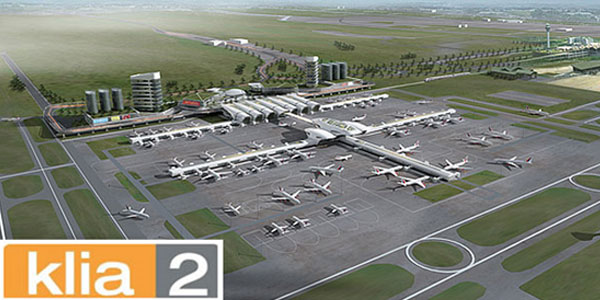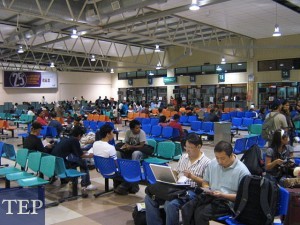14 February 2014
By Kamil Amil
Years ago, Sultan Salahuddin Aziz Shah International Airport, or Subang Airport as we all call it, used to be a convenient travelling hub for a Petaling Jaya / Klang Valley boy like me. I recall those memories travelling in the 1980s to London, Frankfurt and other magical places when I was six years old.

new home of AirAsia.
Every single passenger experience touch points, from check-in baggage, waiting time at the embarkation lounge, the immigration counters, was embraced with enthusiasm. There was a time when Subang airport was getting overly crowded and thus it was a good decision to relocate and build a new airport in Sepang known as the Kuala Lumpur International Airport, and as many people would call it, KLIA.
Nowadays, air travel is no longer a luxury but is a lifestyle. The landscape has changed so much after the liberalisation of the airline industry, giving opportunity to low-cost airline operators to capitalise on the middle-income segment. Air Asia, without doubt the largest low cost airline operator in Asia, has induced and accelerated demand of affordable air travel and provided multiple economic spill-over effects to the Malaysian economy.

We have seen a great deal of healthy competition such as the price war between the legacy carriers such as Malaysia Airlines, Firefly, Air Asia and Malindo Air. The price competition has resulted in more passengers travelling in and out of the airports: KLIA and Low Cost Carrier Terminal (LCCT).
Based on various analyst reports, compounded annual growth for the current KLIA between 2000 and 2010 is at 8.8 per cent per annum. As for LCCT, the maximum capacity is at 15 million people per annum. Compared to Air Asia’s total passengers in 2012 at 19.6 million passengers, it means building a new low-cost airport known as klia2 was a timely move by Malaysia Airports Berhad (MAHB).
With a projected 46 million passengers travelling through the low-cost terminal by 2025, klia2 is an important milestone and investment for MAHB. The Khazanah-owned company wants to ensure that klia2 is built to the “highest specification and remains relevant for a long period of time, universally accepted by all airlines and provides attractive returns to its stakeholders”.
The original plan by MAHB to build a new “low cost terminal” to serve low cost carriers like Air Asia, has now morphed into a “normal” terminal to accommodate other airline or future requirements. It means, unlike traditional low-cost airports, the revised plan means greater functional terminal with higher comfort levels for passengers. Therefore, to not confuse the public, it is termed a hybrid airport.
For MAHB contractors such as UEM Construction, Bina Puri, KUB, Nippon, WCT and many others, changes in the master plan and requirements simply means two things.
The first one is challenges in meeting the original deadline. As the project owner, MAHB was naturally in the limelight last year for failing to comply with its own deadlines, a total of five delays. It is not surprising to experience inevitable consequential delays in other parts of the construction such as electrical, water and sewerage and fire safety related work.
A little background: the Certification of Completion & Compliance (CCC) is the official handover from the contractors to the airport owner, MAHB before Operational Readiness and Acceptance Test (ORAT) can be conducted. CCC as we know, is vital to ensure the contractors adhere to the building standards, regulations and other safety requirements. Given the soil type in KLIA Sepang area, the public at large can already anticipate potential delays due to challenging soil conditions.
The second consequence, which concerns the public at large, is the escalation in cost. Although MAHB is not using the taxpayer’s money, but raised capital partly through share issues, to fund the new airport, we kept hearing how this issue was politicised by certain quarters. We have seen the blame game between MAHB and Air Asia at some point, but the question kept pointing at bad planning as opposed to impromptu and frequent intervention.
Let us remind ourselves that the cost ballooned from RM 2 billion (US$600 million) from the initial figure quoted in February 2009 to a revised figure of RM 3.9 billion (US$1.17 billion) in 2011. The figures here were quoted from various analyst reports from major investment banks.
The original 150,000 square metre gross foot area (GFA) has now been revised to 257,000 square metre GFA. That is a whopping 71 per cent increase from the original scope. To translate financially, it means an additional RM 420 million is needed to increase the passenger capacity from 30 million people per annum to 45 million people per annum.
From projected passenger growth, the klia2 will reach its maximum capacity by 2026, which is only 12 years from now. There was a consensus that 45 million passenger capacity is realistic and is not “too big” as initially feared.
There were additional aircraft stands that require an additional RM 160 million (US$48.2 million) as the number were revised from 50 to 70. Currently Air Asia fully dominates the 35 stands in LCCT. With the number of aircraft that Air Asia has ordered in the next five years and with the new airlines operating in klia2, the amount of aircraft stands must be sufficient to accommodate the growth.
Thirdly, the largest increase in cost was the additional earthwork. This is the biggest bill for klia2’s addition in capital expenditure due to the 131 per cent increase of additional ground work area. And this is translated to the additional RM 670 million (US$201.8 million) of extra cost.
According to MAHB, the additional area will be used to house aircraft maintenance hangars, cargo facilities and more. The public, on the other hand, still firmly believe the additional cost is to strengthen the soil in that area which was a legacy issue since the construction of the KLIA main terminal.
The fourth cost component that contributes to the additional cost is a longer runway. The new runway, called Runway C, will be lengthened and expanded to 3,960 metres and it will be upgraded to a “Code E runway” which means a large bird like Airbus A380 can land safely on Runway C. Experts have said that the lengthening of Runway C is redundant and adds no value. This change in requirement alone will cost additional RM 180 million.
The fifth cost component is MAHB’s generous offer to incur the cost of basic infrastructure such as roads, drainage and sewerage which totalled up to an additional RM 390 million (US$117.5 million). Interestingly, in many other projects, the government is willing to spend that amount of money to spur economic growth. Why MAHB is unable to influence the government’s decision remains unsolved.
The sixth cost component is the aerobridges which was revised to 80 with the additional cost of RM 120 million (US$36.14 million). We all know Air Asia is fighting tooth and nail to not use the aerobridges as they can potentially save approximately RM 4 million per annum -based on RM 85 per use (US$1.2 million – US$25.60 per use). Therefore, a decent trade off would be reviewing the number of aerobridges to around 40.
Having said all that, based on various analyst reports, even with the additional cost, the internal rate of return (IRR) is attractive – 22 years with IRR of 12 per cent and Net Present Value (NPV) of approximately RM 7 billion (US$2.11 billion). And the cash flow analysis project it will be cash flow positive from the first year of operations. MAHB knows the game. It is better to bear the pain now for a long term gain.
Putting the pain aside, as you can see from MAHB’s share price, the investors are already excited. Reading from the recent investor reports, MAHB share is still a “buy” despite possible delay in the klia2 launch. For you and me, the public is anticipating patiently the opening date. With or without delays, every Malaysian deserves to experience the new klia2 without surprises or compromises that can affect passenger’s comfort or safety.
The acting Transport Minister, Dato Seri Hishamuddin Hussein has given the assurance that the klia2’s opening date remains unchanged, i.e 2nd May 2014. At least we hope that that klia2 will not be a continuous saga like the new Bradenburg airport in Berlin, which was delayed for five years. As much as we all hate the consequence of cheap air travel, klia2 is worth the wait as it will be our next landmark in the history of air travel.
This article was kindly contributed by Kamil Amil who has worked in the aviation industry for 10 years, is an avid photographer and a regular airport user. He can be contacted via Twitter at @Kamil_Amil
Source: www.establishmentpost.com
Site Search
Did you find what you are looking for? Try out the enhanced Google Search: